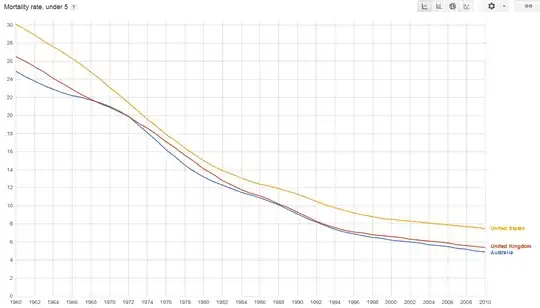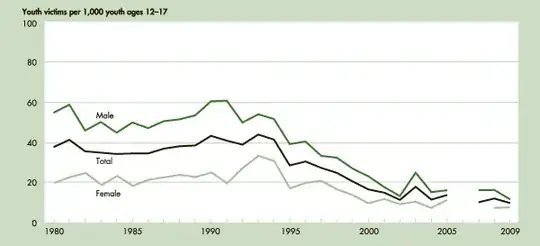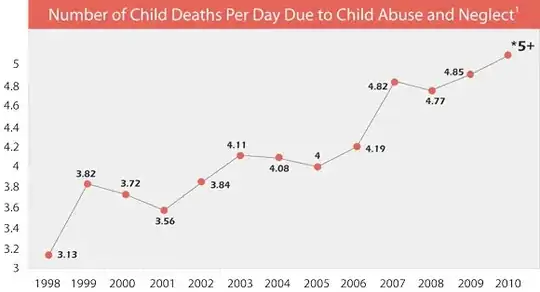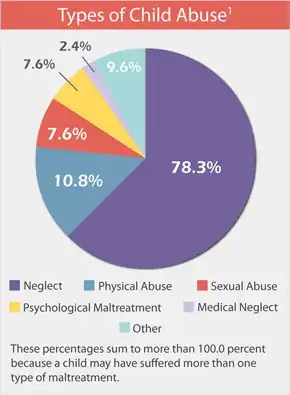"Were children safer in the good old days?"
We have four definition problems here:
- What age are included when talking about "children"?
- What risks are included and excluded in "safe"?
- When were the "good old days"?
- What geographic regions are included? Just the US? UK? Western-style cultures? The globe?
Interpretation #1: Children under 5 years, all mortality risks, 50 years ago, western countries.
Then the answer is provided by World Bank data, extracted by Google:

(I chose USA and UK, because the claims were from there, plus Australia, because that's where I am based, and to show the trends aren't limited.)
Broad summary: Infant mortality has decreased greatly in the past 50 years.
But perhaps they didn't mean to include the fact we have vaccinations and other health improvements, and meant to talk about violent crime?
Intepretation #2: Youths 12-17, victims of violent crime, 30 years ago, USA.
ChildStats.gov has the data:

Broad summary: Youths are less likely to be victims of violent crime.
No, no, maybe they meant to include all the risks of car-accidents and injuries playing sport?
Intepretation #3: Aged 1-4 and 5-14, deaths due to injury, 30 years ago, USA.
Again, ChildStats.gov has the data (with a warning to treat the 2008/09 figures as preliminary):

Broad summary: Children younger than 15 are less likely to die of injuries.
Interpretation #4: Any ages, kidnapping, >15 years ago, USA.
But what about kidnapping?
It is difficult to give a detailed answer here, as it was only recently (e.g. since 1997) that kidnapping has been tracked:
Until recently, the nature and scope of the problem have been unclear because existing crime data collection systems—such as the FBI's Uniform Crime Reporting (UCR) system and OJJDP's National Incidence Studies of Missing, Abducted, Runaway, and Thrownaway Children—do not collect law enforcement data on kidnaping.
Fortunately, that is about to change. In partnership with the Bureau of Justice Statistics, the FBI is supplanting the UCR with the National Incident-Based Reporting System (NIBRS). This will enhance our understanding of youth abduction and create a comprehensive picture of kidnaping offenses.
Fortunately, kidnapping is very rare.
Data indicate that kidnaping of juveniles is a relatively rare crime in NIBRS jurisdictions. It constitutes only one-tenth of 1 percent of all the crimes against individuals, 1 percent of all crimes against juveniles, and 1.5 percent of all violent crimes against juveniles recorded in the database. Kidnaping is dwarfed by the much more common crimes of simple and aggravated assault, larceny, and sex offenses, which make up most of the crimes against juveniles
Kidnapping by a stranger (presumably the relevant subset) is rarer still (a little over a quarter of the offenders, according to the same source).
When we talk about dangers being faced by children, being kidnapped by strangers on the street doesn't contribute much to a child's overall risks.
Intepretation #5: Various ages, child abuse, 15 years ago, USA.
This is where the picture gets less rosy. According to Child Help, deaths due to child-abuse have been on the rise recently:

Note: The y-axis on the graph does not extend to zero, which serves to exaggerate the rise for people unfamiliar with the technique. Also, these are absolute figures, not per capita figures, so the growth should be tempered by the approximately 10% population increase over that period.
Child abuse includes a number of sub-categories:

Without wishing to dismiss the seriousness of this issue, this problem does not seem to fall into the type of issues that the original claims expressed concern about - the dangers of letting their children play on the street.
Conclusion:
Without clearer definitions, it is impossible to give a precise answer, but it seems under a number of different measures, these are the good days when it comes to child safety.




